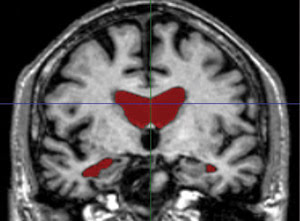
Link to Alzheimer’s may lead to discovery of better treatment
Amanda Francoeur
A study has shown that Alzheimer’s disease, the sixth leading cause of death among people over 65, could be diagnosed at earlier stages of development. Early identification would provide scientists with more time to find a better treatment and possibly a cure.
“It is likely that, with early detection, future therapies may have a more positive impact than if provided at a later stage in the disease process, when a significant amount of tissue is dead,” Sean M. Nestor, a graduate student enrolled in the Robarts Research Institute program at the University of Western Ontario in London, Canada, said.
A study conducted by Nestor and fellow researchers found evidence that enlargement of fluid-filled cavities in the brain (ventricles) are key indicators in the progression toward dementia and Alzheimer’s.
Disease progression
Alzheimer’s occurs because of deterioration of brain tissue over an extended period of time. First, nerve cells become ridden with plaques — clusters of b-amyloid protein fragments — and the buildup, as it blocks cell-to-cell synapses, causes the cells to die. Second, protein strands in the cells become twisted (tangles) and eventually disintegrate, dividing the connection for administering food molecules and other essential particles that the brain needs to survive. Finally, ventricles become larger as a result of brain tissue disintegration. “Tissue atrophy (death) around the ventricles is a principal factor for ventricular enlargement,” Nestor said.
The researchers’ study included 504 MRI images provided by the Alzheimer’s Disease Neuroimaging Initiative, a major research study in the prevention of Alzheimer’s, sponsored by the National Institutes of Health. Images were categorized into three groups: 152 patients with normal elderly controls (NEC), 247 patients with mild cognitive impairment (MCI) and 105 patients with Alzheimer’s disease.

An MRI of the coronal plane of a brain is shown with the lateral ventricles appearing in red. Researchers have found a way to track disease progression by monitoring ventricle volume, which increases as a result of brain tissue deterioration. Reprinted with permission of Oxford University Press.
Patients were evaluated at baseline and during a six-month follow-up period. The study concluded that all three groups showed some indication of ventricle growth. However, patients with Alzheimer’s disease had a 60 percent greater ventricle volume enlargement compared with patients with MCI, and those with MCI had a larger increase compared with NEC patients. This determined that the degree of expansion is a sensitive and apparent biological marker associated with dementia.
There is no cure for Alzheimer’s disease. Deterioration starts at the hippocampus in the temporal lobe, which controls speech, memory and hearing, and progresses to the parietal lobe, which controls sensory information, and the deterioration is permanent. Several drugs are available that can help to slow degeneration and to control behavioral symptoms, but none is able to completely stop or reverse the disorder. However, the study enhanced clinical diagnosis and provided researchers with a more precise measure for evaluating cognitive impairment over time, which, in turn, may lead to the discovery of a more advanced treatment.
Brain, published online July 11, 2008.
Published: September 2008